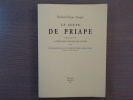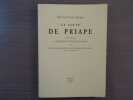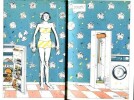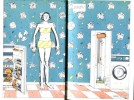423 books for « knight g e o »Edit
-
Type
Book (408)
Music sheets (14)
New book (1)
-
Latest
Last month (17)
Last week (1)
-
Language
English (12)
French (411)
-
Century
18th (2)
19th (19)
20th (222)
21st (37)
-
Countries
Belgium (18)
China (3)
Côte d'Ivoire (1)
Denmark (10)
France (348)
Greece (1)
Switzerland (40)
United Kingdom (2)
-
Syndicate
CNE (1)
ILAB (178)
NVVA (5)
SLACES (5)
SLAM (154)
Topics
- Adam (13)
- Animals (1)
- Anticipation (2)
- Arboriculture (1)
- Architecture (3)
- Architecture/ urban planning/ memorials (1)
- Biology (2)
- Birds (2)
- Botany (4)
- Cartography (1)
- Children’s books (17)
- China (3)
- China (4)
- Cinema (1)
- Cities (1)
- Civilisation (1)
- Comic strip (3)
- Costumes (1)
- Countryside (1)
- Crime (3)
- Curiosa (3)
- Customs (1)
- Detective novels (16)
- Dictionaries (4)
- Divination (2)
- Dressmaking (5)
- Economics (3)
- Embroidery (4)
- England (6)
- English (14)
- English literature (2)
- Entomology (3)
- Esotericism (3)
- Ethnology (1)
- Ethnos (1)
- Europe (2)
- Fantastic (7)
- Fashion (2)
- First edition (6)
- Flora (3)
- Fox (5)
- Freemasonry (6)
- Gay lussac (2)
- Geography (1)
- Hermeticism (2)
- History (20)
- India (9)
- Italy (2)
- Knight christopher (3)
- Knight damon (18)
- Literature (28)
- Lomas robert (3)
- London (1)
- Mammals (1)
- Middle ages (2)
- Music (2)
- Oceanography (1)
- Payne knight richard (4)
- Philosophy (1)
- Physics (2)
- Policy (1)
- Portraits (2)
- Psychology (2)
- Religions (4)
- Reviews (1)
- Rock (2)
- Rock (2)
- Ruth (5)
- Science fiction (8)
- Sciences (5)
- Sciences & technique (3)
- Scores (23)
- Scout (3)
- Shakespeare william (2)
- Sicily (2)
- Sociology (2)
- Songs (14)
- Spying (4)
- Symbolism (3)
- Tea (4)
- Theatre (4)
- Theology (2)
- Tibet (2)
- Tibet pc (2)
- Translation (2)
- Travel (2)
- United kingdom (6)
- United states (2)
- Various (6)
- Waltz (1)
- Warner (1)
- Wildlife (1)
- Williams tennessee (1)
- Yi king (2)
- Youth (6)
"KNIGHT, THOMAS ANDREW. - INTRODUCING GEOTROPISM IN PLANT GROWTH.
Reference : 46062
(1806)
On the Direction of the Radicle and Germen during the Vegetation of Seeds. In a Letter to... Joseph Banks. Read January 9, 1806.
(London, W. Bulmer and Co., 1806). 4to. No wrappers as extracted from ""Philosophical Transactions"" 1806. Pp. 99-108.
First apperance of a milestone paper in plant physiology as the concept of tropistic behaviour arose from the experiments described in this paper. Knight showed that forces, generated by means of a water-wheel, made roots and shoots of seedlings orient themselves to centrifugal forces, just as they do to gravity.Knight's investigations on geotropism ""enabled Knight to distinguish between geotropic and hydrotropic reactions of the root, and opened the whole question of tropic responses, of their physical basis and adaptive significance in the lfe of plants.""(Morton, ""History of Botanical Science"", p. 390.).""His most famous work was on what are now called geotropisms. In a letter read by Banks to the Royal Society in 1806, Knight described how he eliminated the influence of gravitation on germinating seeds: He attached them at various angles to the rim of a vertical wheel which was driven by a stream in his garden to revolve continuously at a rate of 150 r.p.m. As the germinating plants grew, each shoot was directed to the center of the wheel" when a shoot passed the center of the wheel its tip turned back so that growth was still centripetal" the roots grew away from the center. Next he set up a similar structure with the wheel horizontal and rotating at 250 r.p.m. so that the seedlings were influenced by both gravitation of the earth an the centrifugal force. In this case, growth was at an angle of 80° to the vertical, the shoot upward and inward, and the root downward and out. Reducing the rotation to 80 r.p.m. decreased the centrifugal force to such an extent that the plants grew at an angle of 45° to the vertical.""(DSB).
"KNIGHT, THOMAS ANDREW. - INTRODUCING GEOTROPISM IN PLANT GROWTH.
Reference : 46390
(1806)
On the Direction of the Radicle and Germen during the Vegetation of Seeds. In a Letter to... Joseph Banks. Read January 9, 1806.
(London, W. Bulmer and Co., 1806). 4to. No wrappers as extracted from ""Philosophical Transactions"" 1806. With titlepage to 1806, Part I. Pp. 99-108. With a stamp on verso of titlepage.
First apperance of a milestone paper in plant physiology as the concept of tropistic behaviour arose from the experiments described in this paper. Knight showed that forces, generated by means of a water-wheel, made roots and shoots of seedlings orient themselves to centrifugal forces, just as they do to gravity.Knight's investigations on geotropism ""enabled Knight to distinguish between geotropic and hydrotropic reactions of the root, and opened the whole question of tropic responses, of their physical basis and adaptive significance in the lfe of plants.""(Morton, ""History of Botanical Science"", p. 390.).""His most famous work was on what are now called geotropisms. In a letter read by Banks to the Royal Society in 1806, Knight described how he eliminated the influence of gravitation on germinating seeds: He attached them at various angles to the rim of a vertical wheel which was driven by a stream in his garden to revolve continuously at a rate of 150 r.p.m. As the germinating plants grew, each shoot was directed to the center of the wheel" when a shoot passed the center of the wheel its tip turned back so that growth was still centripetal" the roots grew away from the center. Next he set up a similar structure with the wheel horizontal and rotating at 250 r.p.m. so that the seedlings were influenced by both gravitation of the earth an the centrifugal force. In this case, growth was at an angle of 80° to the vertical, the shoot upward and inward, and the root downward and out. Reducing the rotation to 80 r.p.m. decreased the centrifugal force to such an extent that the plants grew at an angle of 45° to the vertical.""(DSB).
Flora
, Schirmer/Mosel, 2000 Paperback with flaps, 80 pages, ENG, 365 x 240 x 11 mm, Perfect condition !, large format, illustrations in colours. ISBN 9783888149108.
The young British photographer Nick Knight discovered the beauty of dried plants on a stroll through the herbarium, the "library of pressed flowers", at the Natural History Museum in London. These flowers were a source of such fascination to the photographer that he has now devoted his second large photo album to them. The charm of their fragile corporeality, their filigree transparency and their subtle colours have delighted Nick Knight for more than three and a half years - the time it took him to select from the over six million plants in the herbarium the photographs for this album. Thousands were considered, several hundred photographed and finally the forty-six "most beautiful" chosen. The entire book is imbued with the aesthetic happiness Nick Knight experienced himself on his photographic journey of discovery and whose effect he described in these words: "These are few things that make one happier than discovering a new way of seeing the familiar. Seeing in a way I could not have imagined. It is a very liberating feeling and one that makes me very optimistic." Sandra Knapp, curator of the plants of Middle America at the Natural History Museum has written short explanatory texts on the individual plants commenting on their biological characteristics as well as on their historical and cultural importance. The way the author weaves into her text a short history of botany, botanical research and techniques as well as a history of the herbarium makes this book a pleasure to read and is indispensable for all those who are interested in botany as a scientific discipline.
Eloise in Paris.
Drawings by Hilary Knight. Max Reinhardt. London. 1958. In-4 (28,5 x 20 cm). (68) pp (gardes comprises) : couvertures de papier toilé bleu, dos et premier plat estampé en or, jaquette en couleurs.
Première édition anglaise. Paris assiégé par la turbulente Eloise, cafés, baguette et Tour Eiffel croqués par Hilary Knight (né en 1926), talentueux illustrateur new-yorkais. Texte de Kay Thompson (1909-1998), agrémenté de joyeuses citations françaises.
Margins, Monsters, Deviants. Alterities in Old Norse Literature and Culture
, Brepols, 2020 Hardback, 248 pages, Size:156 x 234 mm, Illustrations:11 b/w, 3 tables b/w., 1 maps b/w, Language: English. ISBN 9782503585864.
Summary Medieval Icelandic literature has often been reduced to the supposedly realist slendingas gur and their main protagonists at the expense of other genres and characters. Indeed, such a focus obscures and erases the importance of those beings and narratives that move on the margins of mainstream culture - whether socially, ethnically, ontologically, or textually. This volume aims to offer a new perspective on a variety of theoretical and comparative approaches to explore depictions of alterity, monstrosity, and deviation. Engaging with the interplay of genre, character, text, and culture, and exploring questions of behavioural, socio-cultural, and textual alterity, these contributions examine subjects ranging from the study of fragmented and 'Othered' saga narratives, to attitudes towards foreign people and lands, and alterities in mythological and legendary texts. Together the papers effectively challenge long-held perceptions about the lack of ambiguity in medieval Icelandic literature, and offer a far more nuanced understanding of the importance of the 'Other' in that society. TABLE OF CONTENTS List of Illustrations Introduction: Old Norse Alterities in Contemporary Context - REBECCA MERKELBACH AND GWENDOLYNE KNIGHT Categorizing the Werewolf; or, the Peopleness of Shapeshifters - GWENDOLYNE KNIGHT Taming the Wolf: Reading Bisclaret in Light of Old Norse Kennings - MINJIE SU Between Myths and Legends: The Guises of Go mundr of Gl sisvellir - TOM GRANT AND JONATHAN Y. H. HUI 'The coarsest and worst of the slendinga Sagas': Approaching the Alterity of the 'Post-Classical' Sagas of Icelanders - REBECCA MERKELBACH Considering Otherness on the Page: How Do Lacunae Affect the Way We Interact with Saga Narrative? - JOANNE SHORTT BUTLER Surface, Rupture and Contextualities: Conflicting Voices of the Iberian 'Other/s' in Old Norse Literature - RODERICK W. MCDONALD Otherness Along the Austrvegr: Cultural Interaction Between the Rus' and the Turkic Nomads of the Steppe - CSETE KATONA The Man Who Seemed Like a Troll: Racism in Old Norse Literature - ARNGR MUR V DAL N Afterword: Otherness, Monstrosity and Deviation: The Perpetual Making of Identities - RMANN JAKOBSSON
Partition de la chanson : Savin' myself for Bill
Bradbury Wood 1942
Bon état Petit format Piano
Les Bingsters,Hélian Jacques - Freedman Max C.,de Knight Jimmy - Larue Jacques,de Knight Jimmy,Freedman Max C.
Reference : 98199
(1956)
Partition de la chanson : Rock around the clock ( Toutes les heures qui sonnent ) Adhésif sur la tranche intérieur Graine de violence
S.E.M.I 1956
Bon état Format Coquille
Sheila - Knight Holly,Blue Amanda - Knight Holly,Blue Amanda
Reference : 71374
(1981)
The Works of Shakspere (sic). With notes. Imperial edition. With illustrations on Steel from pictures by C.W. Cope, W. P. Frith, C. R. Leslie, Vernon and others. (A biography of William Shakespeare by C. Knight... revised). In 2 volumes, complete with 44 engraved plates.
London, Virtue & Co, n.d. (1873-76), in-folio. Volume 1: 800 p. + 26 engraved plates / Volume 2: 778 p. + 18 engraved plates, pages printed with double col., with usual aging to the paper, in all a clean and fresh copy, plates on heavy paper without stains, full brown morocco, richly gilt on spine and both covers, all edges gilt, a fine copy with only a few traces of use to the corners of the bindings, gilt edges.
A superb copy of this ‘Imperial edition’ with fine steel engravings with all the original tissue guards. The notes are revised by the great Shakespearian critic Charles Knight. Volume I: with a notice of the original editions of the plays. - Comedies - Histories. 1 frontispiece portrait + 1 engraved titlepage + 24 plates / Volume II: Histories - Tragedies - Poems - Plays ascribed to Shakespeare - A brief notice of opinion on the writing of Shakespeare - Indexes. 1 engraved title page + 17 plates. British Museum general catalogue of printed books vol. 220 (London 1964 ed.) col. 26. Image disp.

(SLACES, NVVA)
Phone number : 41 (0)26 3223808
LE CULTE DE PRIAPE et ses rapports avec la théologie mystique des anciens. Suivi d'un Essai sur le culte des pouvoirs générateurs durant le Moyen Age.
Arché Milano 1987 In-8 carré ( 220 X 160 mm ) de 380 pages, broché sous couverture imprimée. 40 planches hors-texte. Très bel exemplaire, non coupé. +++C'est le premier livre traitant exclusivement du culte de Priape. En partant de la survivance d'un rituel phallique dans l'église d'lsernia ( Royaume de Naples ) observé à la fin du XVIIIe siècle, son auteur parcourt l'itinéraire de la religion phallique dans le monde ancien, un peu dans le goût des antiquarians anglais, en essayant de prouver que ce culte obscène est la représentation mystique et dégénérée d'une divinité qui à l'origine était le principe cosmique. [Caillet : "Très rare [.], détails sur les amulettes phalliques et sur le côté psychopathique et sexuel du Sabbat". Knight ( 1750-1824 ) joua un rôle politique actif ( il fut membre du Sénat et de la Royal Society ) amateur d'antiquités et notamment de numismatique, il voyagea beaucoup en Italie et fonda un Musée Phallique qui se trouve actuellement au British Museum. Après la première parution de son livre ( 1786 ), les violentes attaques puritaines de Mathias obligèrent Knight à en racheter tous les exemplaires pour les détruire.
Haley Bill - Freedman Max C.,de Knight Jimmy - de Knight Jimmy,Freedman Max C.
Reference : 94574
(1953)
Partition de la chanson : Rock around the clock Bill Haley and his Comets
Myers Music 1953
Bon état Format Américain Piano
Existences à liquider Editions du champ de mars coll Cristal 21
1961 1961. Andy Knight: Existences à liquider/ Editions du Champ-de-Mars Collection Cristal 21 1961 . Andy Knight: Existences à liquider/ Editions du Champ-de-Mars Collection Cristal 21 1961
Bon état
Hélian Jacques,Trio Raisner - Freedman Max C.,de Knight Jimmy - Larue Jacques,de Knight Jimmy,Freedman Max C.
Reference : 32955
(1956)
Partition de la chanson : Rock around the clock Film avec Glenn Ford Toutes les heures qui sonnent Graine de violence
S.E.M.I 1956
Etat moyen Petit format
Partition de la chanson : Summer showers
Partitions sur la Saison Forster Music 1918
Bon état Grand format Piano
Haley Bill - Ayre Jimmy,Freedman Max C.,Haley Bill,Phillips Mildred,Reichner Bix,de Knight Jimmy,Lattanzi Pep,Bell Freddie,Spickol Max,Russel Al,Pingatore Frank - Larue Jacques,Salvet André,Haley Bill,Lattanzi Pep,Bell Freddie,de Knight Jimmy,Freedman Max C.,Reichner Bix,Phillips Mildred,Ayre Jimmy,Spickol Max,Russel Al,Pingatore Frank
Reference : 90330
(1956)
Partition de la chanson : Rock and Roll Album pour piano et chant de 7 titres : - C'est bath le Rock ! (Teach you to rock) - Toutes les heures qui sonnent (Rock around the clock) - Mambo Rock - Vas-y donc (Giddy-up-a ding dong) - Rock-a-Beatin' Boogie - A-B-C Boogie - Happy Baby ( Ô mon Baby) Rock and Roll
S.E.M.I 1956
Bon état Grand format Piano
( Cartonnages Editions Opta ) - Damon Knight - Romain Slocombe.
Reference : 12001
(1930)
Les Univers de Damon Knight. ( Avec jaquette papier illustrée ).
Editions Opta / Club du Livre d'Anticipation n° 60 de 1976. Fort in-8 cartonnage éditeur pleine toile violette de 486 pages au format 20 x 4x 13,5 cm. Couverture à la Comète. Dos rond avec titre. Plat et intérieur frais. Complet de la rare jaquette papier illustrée et du rhodoïd. Jaquette en état superbe à l'exception du dos pâli, comme toujours. Pages de gardes et illustrations de Romain Slocombe. Tirage unique à 5000 exemplaires ( n° 312 ). Edition originale en bel état général.
Site Internet : Http://librairie-victor-sevilla.fr.Vente exclusivement par correspondance. Le libraire ne reçoit, exceptionnellement que sur rendez-vous. Il est préférable de téléphoner avant tout déplacement.Forfait de port pour un livre 7 €, sauf si épaisseur supérieure à 3 cm ou valeur supérieure ou égale à 100 €, dans ce cas expédition obligatoire au tarif Colissimo en vigueur. A partir de 2 livres envoi en colissimo obligatoire. Port à la charge de l'acheteur pour le reste du monde.Les Chèques ne sont plus acceptés.Pour destinations extra-planétaire s'adresser à la NASA.Membre du Syndicat Lusitanien Amateurs Morues
Les Univers de Damon Knight. ( Avec jaquette papier illustrée et rhodoïd ).
Editions Opta / Club du Livre d'Anticipation n° 60 de 1976. Fort in-8 cartonnage éditeur pleine toile violette de 486 pages au format 20 x 4x 13,5 cm. Couverture à la Comète. Dos rond avec titre. Plat et intérieur frais. Complet de la rare jaquette papier illustrée et du rhodoïd. Petits frottis et légères brunissures à la jaquette, qui présente un dos pâli. Pages de gardes et illustrations de Romain Slocombe. Tirage unique à 5000 exemplaires ( n° 4483 ). Edition originale en bel état général.
Site Internet : Http://librairie-victor-sevilla.fr.Vente exclusivement par correspondance. Le libraire ne reçoit, exceptionnellement que sur rendez-vous. Il est préférable de téléphoner avant tout déplacement.Forfait de port pour un livre 7 €, sauf si épaisseur supérieure à 3 cm ou valeur supérieure ou égale à 100 €, dans ce cas expédition obligatoire au tarif Colissimo en vigueur. A partir de 2 livres envoi en colissimo obligatoire. Port à la charge de l'acheteur pour le reste du monde.Les Chèques ne sont plus acceptés.Pour destinations extra-planétaire s'adresser à la NASA.Membre du Syndicat Lusitanien Amateurs Morues
Knight's Excursion Companion. Excursions from London.
London, Charles Knight, 1851. Fine contemp. hcalf. Raisedbands, richly gilt spine, titlelabel with gilt lettering. With 20 chapters, each with 24 pp. and 1 engraved plate, the last chapter: 20 pp. Internally fine and clean. Describing 20 cities in the neighbourhood of London, each with a plate with a view and the main buildings.
Sept étrangers (Port of Seven Strangers)
" La Tour de Londres " n° 8 / Nicholson & Watson (Bruxelles) (1947) - In-8 broché de 224 pages - Couverture en couleurs - Traduction de Claude Janvier - Exemplaire en très bon état
L'immonde invasion
Collection "Gore" n° 77 - Editions Fleuve Noir (1988) - In-12 broché de 154 pages - Couverture en couleurs de TOPOR - Très bon état
Collection dirigée par Alain Garsault et André Ruellan
( Science-Fiction ) - H.F. Heard - André Piljean - R. Bretnor & Kris Neville - Elisabeth Sanxay Holding - Damon Knight - Maurice Renard - Ann W. Griffith - Jacques Bergier - Igor B. Maslowski - Fereydoun Hoveyda - Jacques Bergier - Maurice Renault.
Reference : 30373
(1959)
Fiction n° 2. La Revue Littéraire de tous ceux qui s'interessent à la fiction romanesque dans le domaine de L'Etrange, du Fantastique, du Surnaturel, de l'Anticipation Scientifique. Edition en langue française de The magazine of Fantasy and Science Fiction.
Editions Opta / Revue Fiction n° 2 du 15 décembre 1953. In-12 broché de 128 pages au format 19 x 13,5 cm. Couverture illustrée. Dos carré. Plats et intérieur frais, malgré de légère frottis aux coins et aux mors. Contient des nouvelles par H.F. Heard, André Piljean, R. Bretnor & Kris Neville, Elisabeth Sanxay Holding, Damon Knight, Maurice Renard, Ann W. Griffith, suivies de chroniques sur les livres et le cinéma par Jacques Bergier, Igor B. Maslowski et Fereydoun Hoveyda. Présentation et commentaires de Jacques Bergier et Maurice Renault. Très bel état général. Rare édition originale.
Site Internet : Http://librairie-victor-sevilla.fr.Vente exclusivement par correspondance. Le libraire ne reçoit, exceptionnellement que sur rendez-vous. Il est préférable de téléphoner avant tout déplacement.Forfait de port pour un livre 7 €, sauf si épaisseur supérieure à 3 cm ou valeur supérieure ou égale à 100 €, dans ce cas expédition obligatoire au tarif Colissimo en vigueur. A partir de 2 livres envoi en colissimo obligatoire. Port à la charge de l'acheteur pour le reste du monde.Les Chèques ne sont plus acceptés.Pour destinations extra-planétaire s'adresser à la NASA.Membre du Syndicat Lusitanien Amateurs Morues
NICK KNIGHT FLORA (PAPERBACK) /ALLEMAND
Schirmer Mosel; 1er édition (1 mars 2004)
Livre à l'état de neuf, très frais sans annotations ni défauts dissmulés.
India Knight's Beauty Edit
Fig Tree (11/2023)
LIVRE A L’ETAT DE NEUF. EXPEDIE SOUS 3 JOURS OUVRES. NUMERO DE SUIVI COMMUNIQUE AVANT ENVOI, EMBALLAGE RENFORCE. EAN:9780241672556
Orthodox Christianity and Modern Science: Theological, Philosophical, Scientific and Historical Aspects of the Dialogue
, Brepols, 2022 Hardback, 186 pages, Size:156 x 234 mm, Language: English. ISBN 9782503592671.
Summary Orthodox Christian theology is based on a living tradition that is deeply rooted in Greek Patristic thought. However, few systematic proposals about how this theology can respond to questions that arise from modern science have yet appeared. This volume, consisting of eleven essays by different authors about how this response should be formulated, therefore represents a significant contribution to Orthodox thinking as well as to the broader science-theology dialogue among Christians. The variety of approaches in the essays indicates that there does not yet exist among Orthodox a consensus about the methodology that is appropriate to this dialogue or about how the questions that arise from specific scientific insights should be answered. Nevertheless, they indicate the ways in which Orthodox approaches to science differ significantly from most of those to be found among Western Christian scholars, and in this way they point to an underlying unity of perspective that is rooted in the Orthodox tradition. TABLE OF CONTENTS Preface General Aspects of the Dialogue between Orthodox Theology and Natural Sciences Christopher C. Knight, Tradition Seeking Understanding Doru Costache, One Description, Multiple Interpretations Sergey S. Horujy, Cosmic Liturgy, Orthodox Theology, and Integral Ecological Expertise Philosophical Aspects of the Dialogue between Orthodox Theology and Science Alexei V. Nesteruk, The Dialogue between Theology and Science in View of an Irreducible Ambiguity in Hermeneutics of the Subject Tatiana Litvin, Knowledge of God and Phenomenological Foundations of Religious Experience Orthodox Theology of Nature, Ecological Insights and Bioethics Elizabeth Theokritoff, Orthodox Theology, Ecology and Science Bruce Foltz, 'The Lord Is in this Place, Yet I Did Not See It' Gayle E. Woloschak, Reflections on Gene Editing Technology Historical Aspects of the Relationship between Orthodox Theology and Science Adrian Lemeni, References of Father Dumitru Staniloae's Thought in the Dialogue between Theology and Science Kirill Kopeikin, Contemporary Russian Orthodoxy Gheorghe Stratan, Orthodoxy and Future Science
Eagle Bird books a lot of 3. - 1) MACPHERSON, H. B.. The home-life of a golden eagle. 1911. 80 p. / 2) SETON, Gordon. Days with the golden eagle. 1927. 196 p. + photographs. / 3) KNIGHT, C.W.R.. Mr. Ramshaw my eagle. 1933. 128 p. + photographs.
1911, 1927, 1933, gr. in-8vo, small legacy stamp ‘Guggisberg’, clothbound.

(SLACES, NVVA)
Phone number : 41 (0)26 3223808
 Write to the booksellers
Write to the booksellers





















